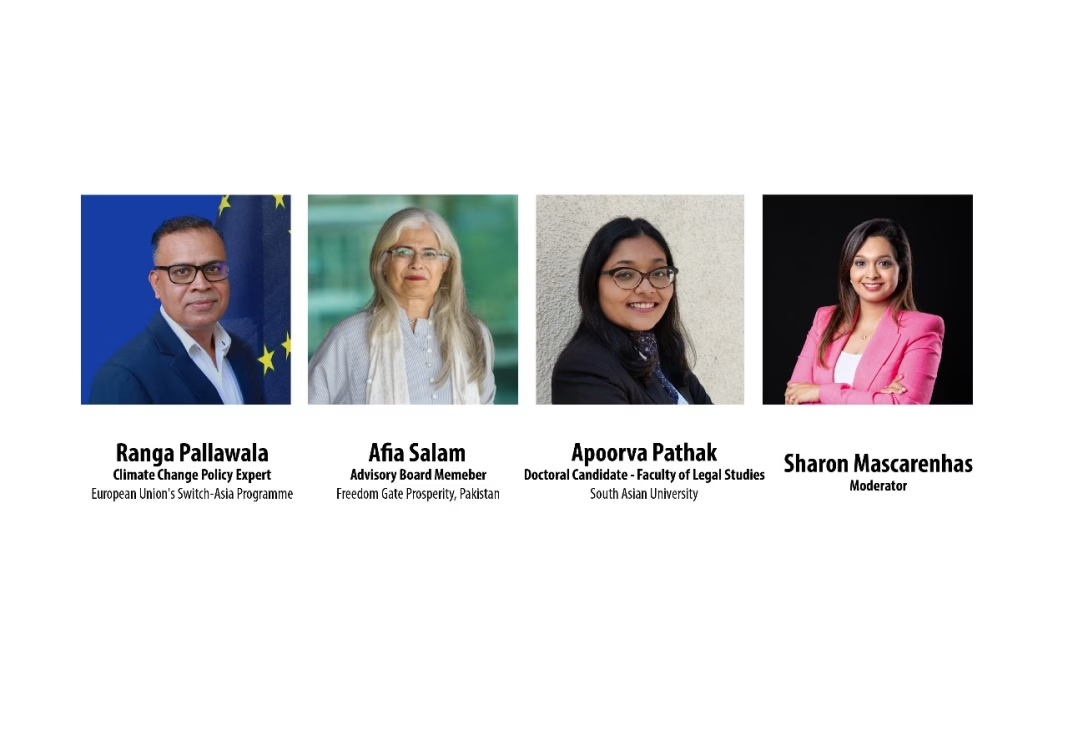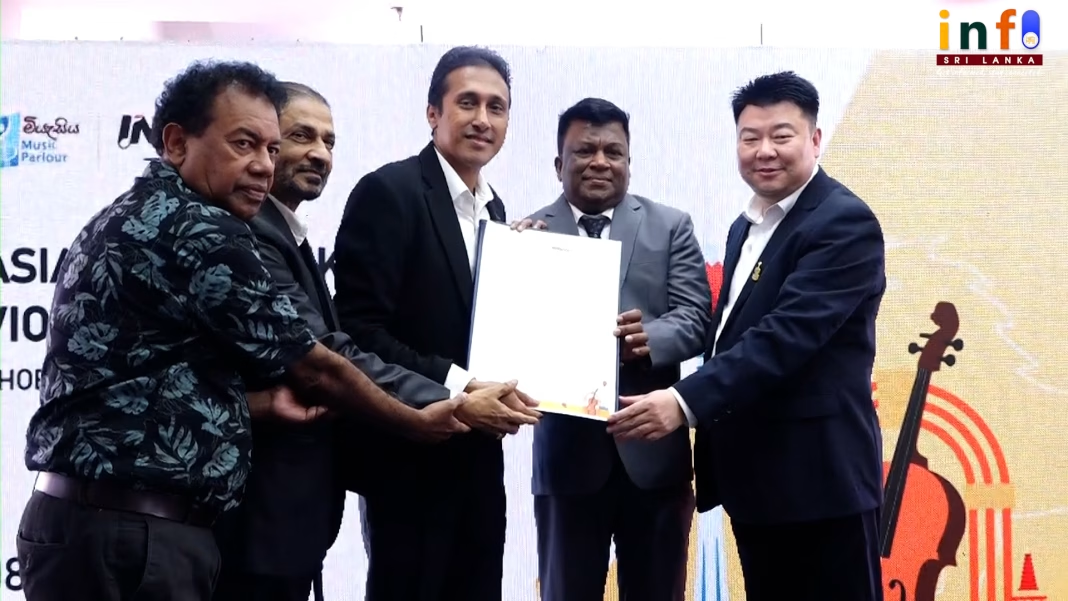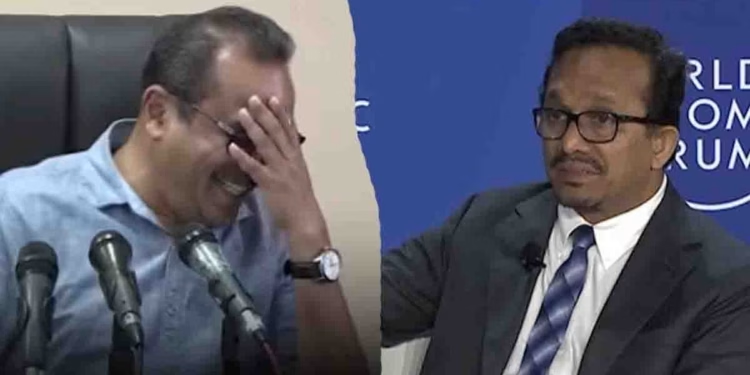By Climate Change Communication Hub
As the world confronts escalating climate disasters, the recent webinar “Beyond the Science: The Missing Piece in Climate Action – Communication” organized by the Climate Change Communication Hub in Sri Lanka brought together leading voices from South Asia to discuss why, despite robust science and decades of policy, the climate message continues to falter—and what must be done to fix it.
The panel featured Mr. Ranga Pallawala (Sri Lanka), a climate policy expert from the EU’s Switch-Asia Programme; Ms. Afia Salam (Pakistan), veteran journalist and environmental advocate; and Ms. Apoorva Pathak (India), doctoral researcher in international climate law. Moderated by Sharon Mascarenhas, the event delved deep into the communication chasm between climate knowledge and everyday action.
“Like a Car on a Cliff”: Ranga on the Urgency of Climate Action
Ranga Pallawala used a powerful analogy to drive home the stakes. “When you go to the peak without a break and start coming down, you cannot stop. It’s the same with climate change—once we cross certain thresholds, we lose control.” According to Ranga, the world is nearing that irreversible tipping point. “We are narrowing the space to act. If we don’t change direction now, we may not be able to reverse the consequences within this century.”
But Ranga emphasized that climate change is not just an environmental issue. “It affects every sector—health, economy, infrastructure, and education. Yet, our governance and institutions are structured for yesterday’s problems.” Alarmingly, he noted, “It’s even difficult to teach some doctors about climate change. That’s how disconnected the sectors are.”
Art Meets Science: Afia Calls for a Paradigm Shift
Afia Salam urged a shift in how we think and feel about the climate crisis. “Climate communication is both an art and a science,” she said. “It’s no longer about convincing people that climate change is real. The science is settled. What we need is relevance and resonance.”
She pointed out that climate change remains abstract to many because the messaging is often scientific and inaccessible. “We need to move from graphs and reports to storytelling. Use music, sports, religion, and art to connect with hearts, not just minds.” Quoting her experience with youth activism and local traditions, Afia argued for using street theatre, poetry, religious teachings, and oral storytelling as communication vehicles.
Why the Message Fails
So why does the climate message still fail to land? According to Ranga, one reason is its confrontational tone. “Often, we point fingers instead of inviting collaboration. We say the private sector is to blame, but forget that we’re part of the same market system.” He argued that communication strategies should focus on contribution over confrontation, building coalitions that include small businesses, farmers, architects, and households.
Afia echoed this, noting that climate activism must bridge silos. “The message fails when it’s abstract, jargon-heavy, or disconnected from lived experience. Communication needs to be tailored: what works for a glacial community won’t work for a coastal village.”
Apoorva added that for many in South Asia, daily survival takes precedence. “If people have food, water, and shelter, they don’t see why climate change matters—even though it impacts all those things.” She advocated for linking climate communication to immediate, relatable concerns: rising food prices, health risks, flood disruptions, and job loss.
The Missing Middle: Stakeholders Who Must Step Up
The panel agreed that key stakeholders are missing from the climate conversation—most notably the private sector. Ranga stressed that while public financing is crucial, it alone cannot solve the crisis. “Even if all developed countries give 25% of their GDP for climate finance, it’s not enough. We need private sector investment—from households to corporations—to shift markets and consumption patterns.”
He emphasized that changing the market system requires communicators to frame sustainability not as sacrifice, but as smart investment. “If you build a house, do it sustainably. If you’re a shop owner, stock green products. But people won’t act unless they see the value.”
Afia proposed another overlooked stakeholder: teachers. “Teachers are bridge builders between science and society. If we empower educators to integrate climate content creatively, it can reshape entire generations.”
Education, Youth, and Law: Apoorva on Building the Future
Apoorva highlighted that children and youth hold the key to long-term change. “Education from an early age must include climate change – not just in science, but in social studies, civics, even art.” She cited examples of student-led petitions and legal activism across the region, including a nine-year-old’s climate case in India and the global push for an International Court of Justice opinion on state obligations.
She also pointed to the courts as emerging climate actors. “In India, Sri Lanka, and beyond, courts are increasingly recognizing the right to a healthy environment. But this activism needs public support, which can only come through education and communication.”
Towards a New Playbook: What Next?
Ranga, borrowing again from the cricket metaphor that united the panel, said: “In an age of T20, we are still playing Test matches with climate communication.” He called for rapid, high-impact outreach using modern platforms and messengers – social media influencers, athletes, local heroes. “We need more ‘sector champions’ who speak climate in their own language. An aviation expert should talk about air turbulence. A chef should talk about food waste. That’s how we build a snowball effect.”
Afia added that the climate message must be seen through the lens of justice. “This is no longer just about climate change. It’s about climate injustice – where those least responsible are most affected. Until people see that, real action will lag.”
Conclusion: A Call to Action
The message from the webinar was clear: science alone will not save us. If we want to shift behavior, mobilize resources, and protect our shared future, we must rethink how we communicate climate change. This means crossing boundaries – between disciplines, sectors, and generations.
It’s time to move beyond the science and toward meaningful, inclusive, and actionable storytelling that empowers communities, influences policy, and turns awareness into impact.
As Ranga summed up, “There’s no tomorrow. We must act now – and we must speak to everyone, everywhere.”





